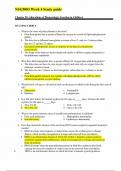Examen
NSG5003 Week 4 Study guide, All Exam Questions & Answers
- Cours
- Établissement
NSG5003 Week 4 Study guide, All Exam Questions & Answers-1. What is the cause of polycythemia in the fetus? a. Fetal hemoglobin has a greater affinity for oxygen as a result of diphosphoglycerate (DPG). b. The fetus has a different hemoglobin structure of two - and two -chains rather than ...
[Montrer plus]



